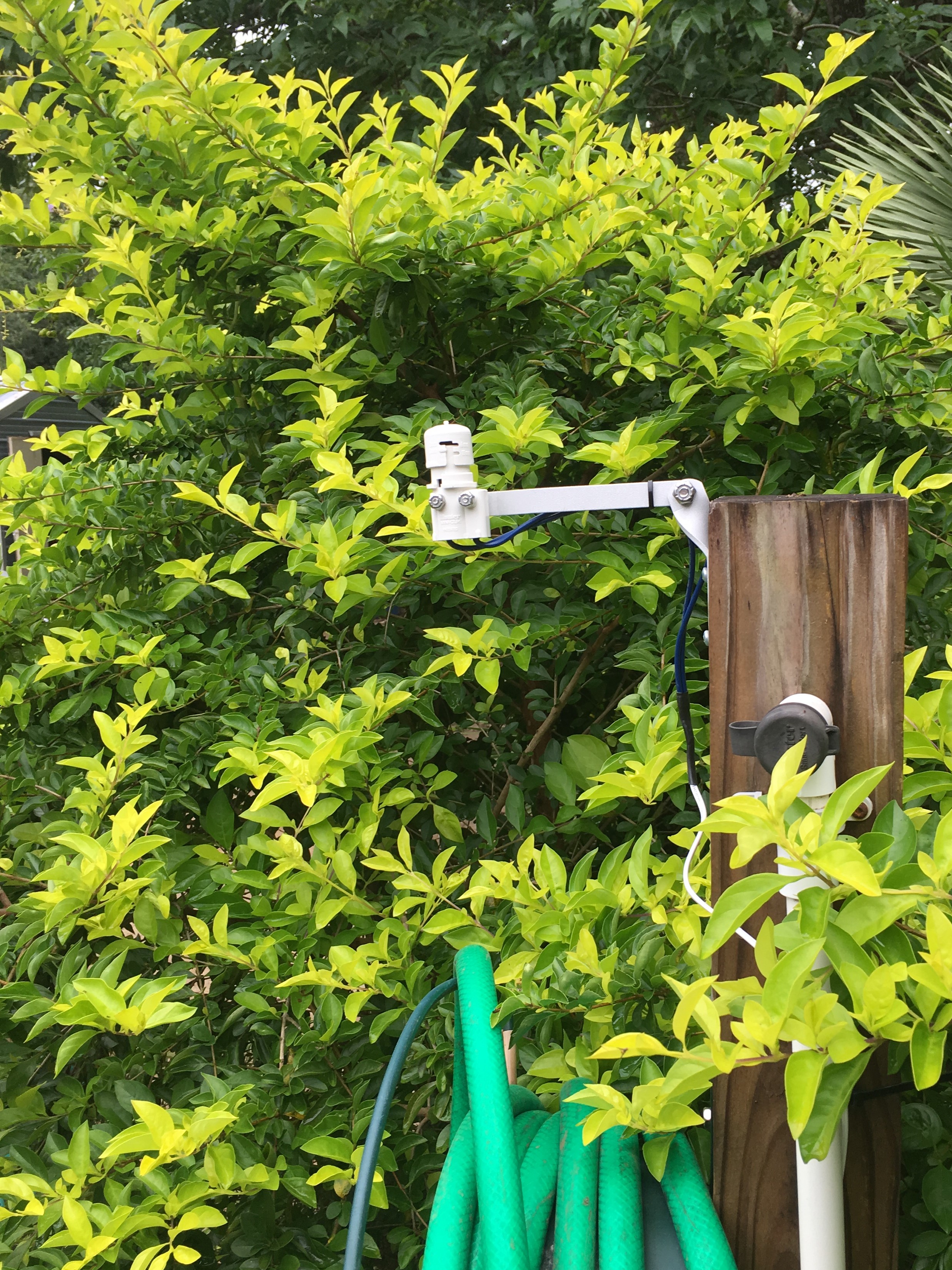
by Mark Tancig | Jun 22, 2017
Recent rains in the panhandle have kept many gardeners indoors. While we’re mostly watching the rain from inside, there are some lawn and landscape tasks to consider.
The most obvious is to turn off any automatic irrigation systems. Although rain shut-off devices are required for all automatic irrigation systems in Florida, many homeowners’ systems are not properly installed, are turned off, or are absent all together. Irrigating during times of adequate rainfall not only wastes a precious natural resource, but it can also be damaging to your turf and landscape plants by creating the perfect conditions for disease, especially fungi.
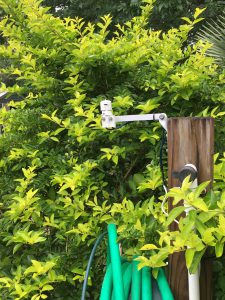
A rain shut-off device ensures that your irrigation system doesn’t come on during rainy weather. Photo by: Mark Tancig, UF/IFAS.
Something else to consider during all of this rain are potential mosquito breeding sites. Our most irritating mosquito species, those day-biting Asian tiger mosquitoes, love to breed in any small or large, water-holding containers around the house, including birdbaths, plant pot saucers, watering cans, five-gallon buckets, tarps, rain barrels, and the list goes on. The best method of control is to drain these containers every three to five days to prevent mosquito larvae from hatching. Another way to reduce larvae from hatching is to use a Bti product, which come in donut shaped dunks or as crumbles that can be sprinkled in the container. Bti controls mosquito, blackfly, and fungus gnat larvae, but does not harm beneficial insects and animals like birds, bees, butterflies, lizards, and frogs. If mosquitoes from the swamp or wetland behind your lot worry you, remember that those ecosystems have a diversity of insects that prey on mosquito larvae. Those containers in the yard do not have predators and can be a large source of the most aggravating mosquito species. For control of larger areas, including those natural ecosystems, contact your local mosquito control agency for assistance.
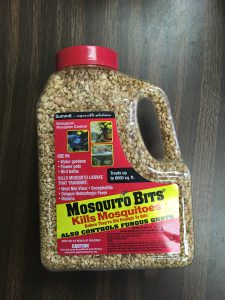
Bti bits are a way to prevent mosquito larvae from becoming biting adults. Photo by: Mark Tancig, UF/IFAS.
If you like to play in the rain a little, this is a good time to walk around and observe any runoff issues in the yard (make sure to do this only when it’s safe!). The ideal situation is to have runoff drain away from the house and percolate into landscaped areas. When surveying the yard in the rain, things to look for include areas of standing water (that could be a good location for a rain garden) and areas where erosion may be occurring (consider using berms or plantings to better direct and slow the water). Before doing any major drainage work, always check with your local building department. Some municipalities may require permits to ensure your improvements do not affect your neighbors or others downstream.
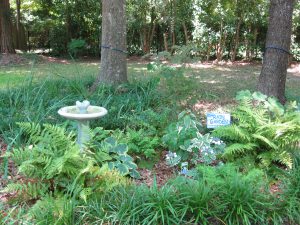
Rain gardens can turn a low, soggy spot into an aesthetic addition to your yard. Photo by: Courtney Schoen, TAPP.
If you have any questions about rain shut-off devices, mosquito control, or stormwater runoff, contact your local UF/IFAS Extension office for more information. Enjoy the rain; it will be sunny and hot before you know it!
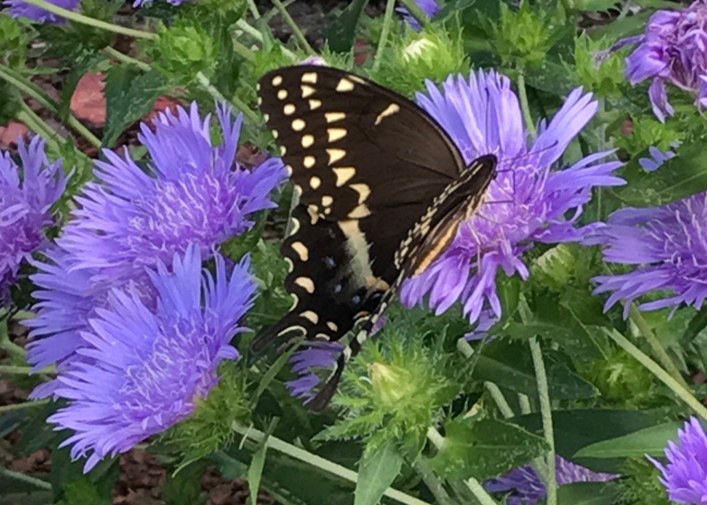
by Mary Salinas | Jun 22, 2017
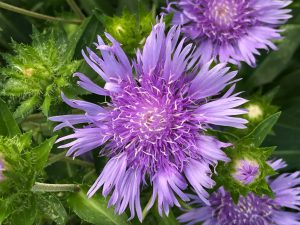
‘Mel’s Blue’ Stokes’ Aster. Photo credit: Mary Derrick, UF/IFAS Extension.
Florida is home to some of the most beautiful flowering perennials. An exceptional one for the panhandle landscape is Stokes’ aster (Stokesia laevis) as it is showy, deer resistant and easy to care for. Unlike other perennials, it generally is evergreen in our region so it provides interest all year.
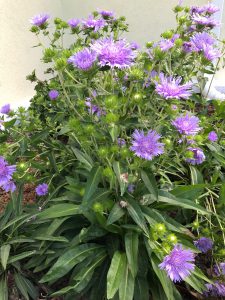
Upright habit and profuse blooming of ‘Mel’s Blue’ Stokes’ Aster. Photo credit: Mary Derrick, UF/IFAS Extension.
The original species of Stokes’ aster has purplish-blue flowers but cultivars have been developed with flowers in shades of white, yellow, rosy-pink and a deep blue. The flowers are large, eye-catching beauties that bloom in spring and summer. They also last well as a cut flower. You will find that bees and butterflies will appreciate their nectar! Remove spent flowers after blooms have faded in order to encourage repeat flowering.
A location in your landscape that provides part sun with well-drained rich soil is best for this perennial. Stokes’ aster is native to moist sites so it does best with regular moisture.
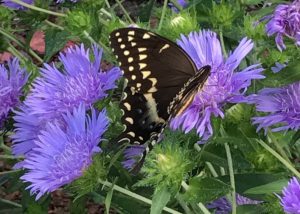
Stokes’ aster attracts butterflies like this black swallowtail. Photo credit: Mary Derrick, UF/IFAS Extension.
As with many perennials, the plant will form a large clump after a few years; this gives you the opportunity to divide the clump in the fall and spread it out in your landscape or share the joy with your gardening buddies.
For more information:
Gardening with Perennials in Florida
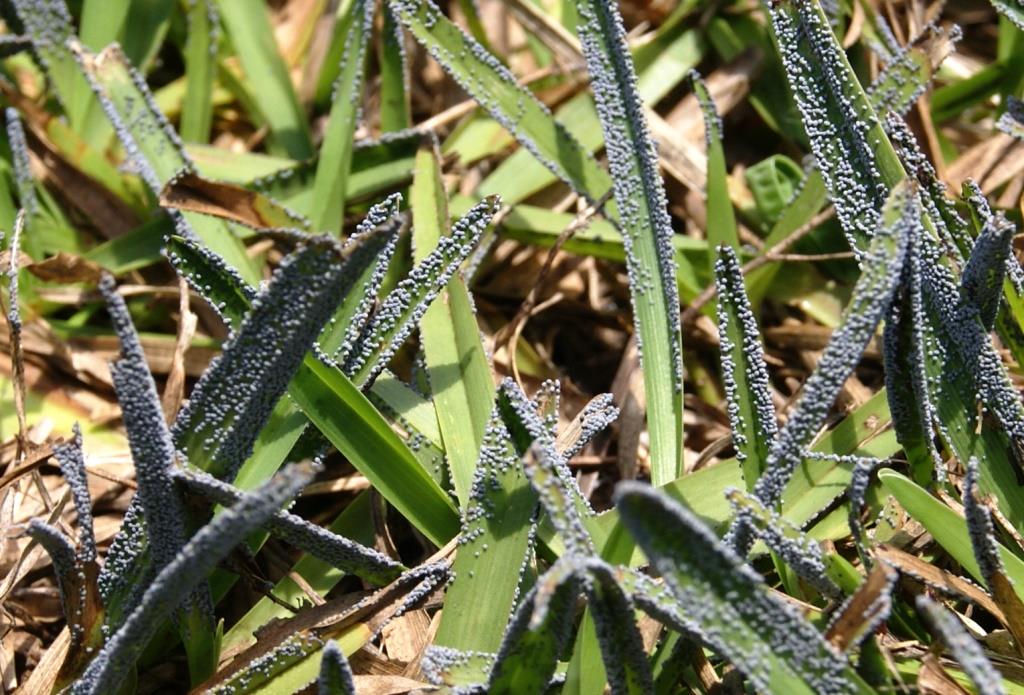
by Matthew Orwat | Jun 16, 2017
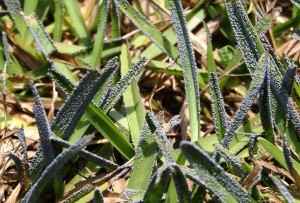
Slime Mold Sporangia. Image Courtesy Matthew Orwat
Although black or white streaks are shocking when they appear on an otherwise healthy lawn, slime molds are rarely harmful.
Slime mold is actually caused by the reproductive structures of an array of different organisms, classified as plasmodia or Protista, which are regularly present in the soil. They are often mistaken for fungi. The different types are referred to as myxomycetes or dictyosteliomycetes. They usually appear on warm humid days in late spring or early summer after extended periods of rain. This extended period of heat and humidity, as is currently being experienced in the Florida Panhandle, initiates the perfect climate for slime mold development.
While regularly present in the soil, they usually make a visual appearance on warm humid days in late spring or early summer after extended periods of rain. This extended period of heat and humidity, currently being experienced in the Florida Panhandle, initiates the perfect climate for slime mold development.
As depicted in the picture, slime mold makes the lawn look like it was just spray-painted with black or grey paint. They can sometimes be pink, white, yellow or brown as well. The round fruiting bodies, called sporangia, carry the spores which will give rise to the next generation of the mold. After a few days the sporangia will shrivel up, release the spores and leave no noticeable trace on the lawn.
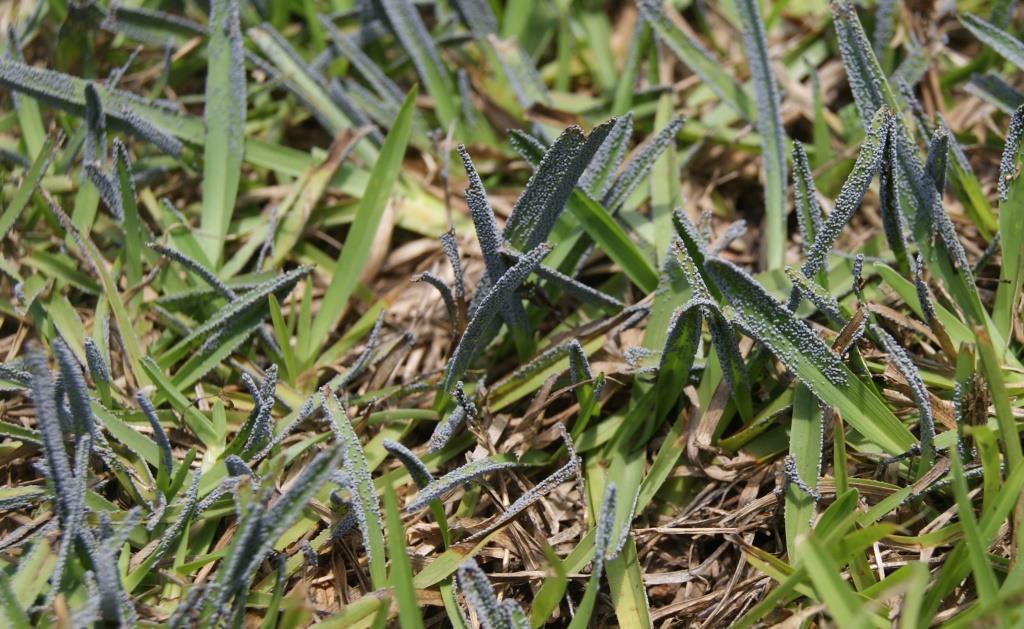
Closeup: Slime Mold in Centipedegrass. Image courtesy Matthew Orwat
Currently, no fungicide exists to control slime mold because chemical control is not necessary. An excellent method to speed up the dissipation of slime mold is to mow or rake the lawn lightly. This will disturb the spores and hasten their departure. Another effective removal method is to spray the lawn with a forceful stream of water. This process washes off the slime mold sporangia and restores the lawn to its former dark green beauty.
Excessive thatch accumulation also increases the probability of slime mold occurrence.
For more information consult your local county extension agent consult the UF / IFAS Slime Mold Fact Sheet, or read the Alabama Cooperative Extension publication Slime Mold on Home Lawns.
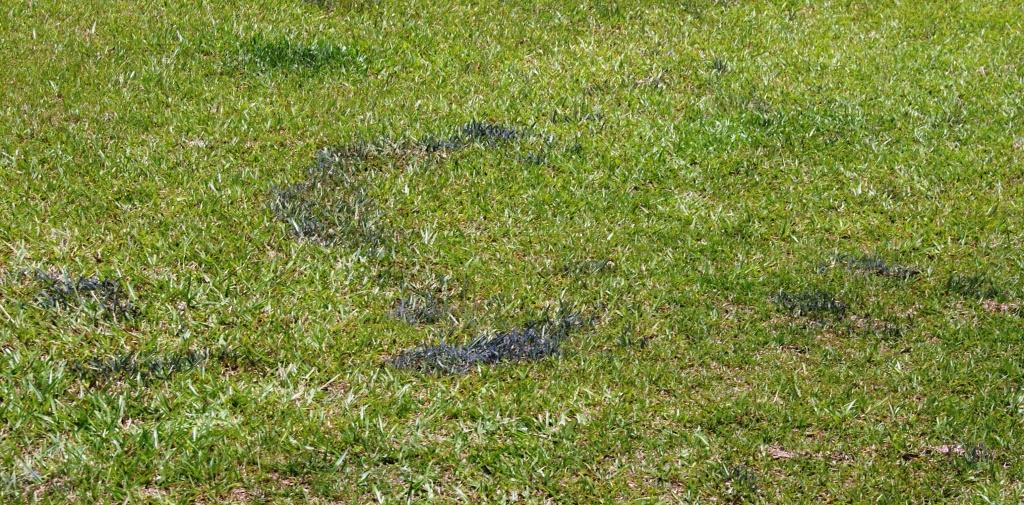
Slime Mold in Centipedegrass. Image Courtesy Matthew Orwat
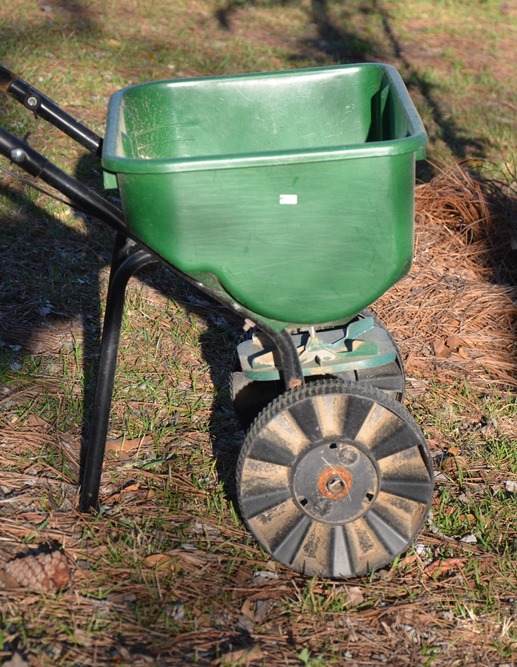
by Les Harrison | Jun 15, 2017
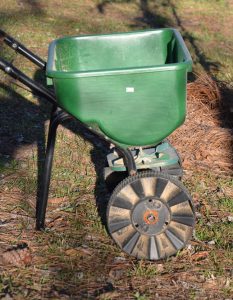
Fertilizer spreader use is in full swing throughout the Florida panhandle
Fertilizing a lawn properly in the summer can enhance the landscape without inducing disease or harming the environment .
One universal activity is seasonal lawn and landscape maintenance. While some consider it a chore, many view it as a means to enhancing their personal environment.
The list of tasks are, for the most part, standard with few surprises. Raking leaves and pine straw, replacing shrubs which did not make it through the winter, and fertilizing the lawn and landscape.
While a routine undertaking, applying fertilizer requires thought and consideration to be effective without negative consequences. It should be a deliberate and well-planned accomplishment which is science based.
The proper selection of a fertilizer should be based on a soil test. Every UF/IFAS Extension Office has supplies for pulling and submitting a soil sample for evaluation.
The results, which can come via mail or e-mail, will tell the homeowner what nutritional deficiencies exist in their lawn and landscape. Based on the type of grass or shrubs, the report will deliver the information on the fertilizer analysis needed for optimum plant performance.
With this information in hand, the homeowner can visit a local retailer who can provide the product which meets the needs of the landscape without wasting excess nutrients. Excess soil nutrients can easily be relocated to bodies of water when storm water washes it downstream.
Homeowners have several types of fertilize from which to choose for use on their lawn. Each has distinct advantages and disadvantages.
Dry blend fertilizer is usually the least expensive and is easy to find in the market place. It is a mixture of minerals and compounds which are combined to produce a particular analysis, such as 10-10-10.
This analysis is ten percent nitrogen, ten percent phosphorus, and ten percent potassium with the remaining 70 percent being micronutrients and inert carrier. Applied correctly, it can be effective at delivering the needed nutrients.
It is most effective when applied several times throughout the growing season. The grass and shrubs will then have a continuous supply of the needed nutrients over time.
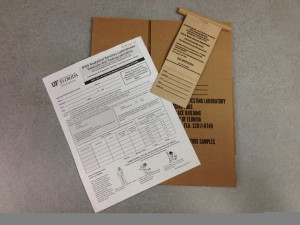
Soil test kit available from your local Extension office. Photo: Mary Derrick, UF/IFAS.
One potential problem with dry blend fertilizer is the particle size of the different nutrients. If irregular, they can separate during transportation to the retailer.
This can be easily corrected by the homeowner. Just pour the contents of the bag into a container and mix using a can or shovel.
Dry slow-release fertilizers are gaining popularity, but they are more expensive. They have a sulfur or polymer coating on the particles which allows for the slow release of the nutrients.
A single application can last for up to six months which frees the homeowner to pursue other activities. The most common use of this product is with shrubs and potted plants.
Liquid fertilizer concentrates are available, but the convenience comes at a high cost. It is easily diluted for use, but uniform application over a large area can be challenging.
No matter which form is used, proper application will grow good results. A healthy and well maintained lawn and landscape leave more time for other springtime pursuits.
To learn more about the fertilizer for your landscape, contact your county agent and refer to this section on our website devoted to lawn fertilization.
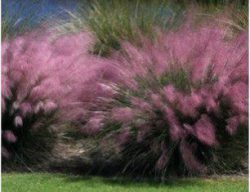
by Carrie Stevenson | Jun 15, 2017

Salt shear and onshore breezes often cause coastal maritime forests to grow at a slant away from the coast. Credit: Florida Master Naturalist Program
People from other parts of the country often move into Florida with expectations of their landscape beyond its capabilities. Those gorgeous peonies that grew up north or the perfect tomatoes they grew in California seem to wither in the heat or succumb to any number of insect or fungal pests. Adapting to our conditions takes listening to those with more experience, changing old habits or varieties and definitely adjusting expectations. Once you understand what the north Florida climate requires, you might be pleasantly surprised with a bumper crop of lemons or a thriving hibiscus that would never have worked in Michigan.
The same idea applies to landscaping on the beach or near areas of saltwater. Particularly on barrier islands like Perdido Key, Santa Rosa Island, and the coastal islands around Apalachicola, the influence of salt spray and hot, dry, sandy soils cannot be underestimated. If you have ever looked closely at the shape of the mature oak trees on the back sides of sand dunes, you’ll notice they’re shorter and tend to lean and grow away from the beach. This is due partially to the onshore breeze that steadily blows off the water, but also due to a phenomenon called salt shear. Salt shear occurs in areas where breaking waves release salt, which evaporates from water droplets and blows into the landscape. Unless specifically adapted to living in a saline environment, the salt can halt growth of the plants receiving the bulk of the spray. Many plants adapt to this by sealing up any vulnerable growing tips and sending energy for growth to the other side, resulting in a sloped shape. Land further inland from the Gulf will have consecutively less salt spray to endure.
Keep in mind that the soil on a barrier island is highly porous; it does not hold water nor nutrients well. The best option is to look at what grows there naturally, and select some of the most attractive and hardy choices for a home or commercial landscape. Knowing that a residence or commercial business is located within these environmental conditions, the best way to ensure success is to work with your surroundings instead of against them.
Below are a handful salt-tolerant options to consider.
Beach sunflower (Helianthus debilis): The yellow-blooming beach or dune sunflower will reseed and spread along as a hardy groundcover.
Muhly grass (Muhlenbergia capillaris): Muhly grass is a native clumping grass commonly used in Florida landscapes. It has showy pinkish-purple blooms in mid-fall.
Beach cordgrass (Spartina patens): Beach cordgrass is a native grass that serves as a sand stabilizer. While not particularly showy, it can serve as a good foundation plant.
Saw palmetto (Serenoa repens): These evergreen shrubs are extraordinarily hearty and long-lived. They produce a fruit that is an important food source for wildlife.
False rosemary (Conradina canescens): This evergreen shrub blooms purple, attracts wildlife, and is a hardy native species.
Firebush (Hamelia patens): Firebush has long-lasting red blooms that attract hummingbirds and native butterflies.
Blanketflower (Gaillardia pulchella): These colorful wildflowers attract pollinators like bees and butterflies and are extremely drought and salt tolerant.
Sunshine mimosa (Mimosa strigillosa): This ground-running plant has colorful, spherical pink blooms and attracts bees. The delicate leaves of the plant are sensitive to touch, and will fold up when touched.
For more information on salt-tolerant coastal plants and trees in our area along with cold-tolerant palms, contact your local Extension agent or Native Plant Society.

















